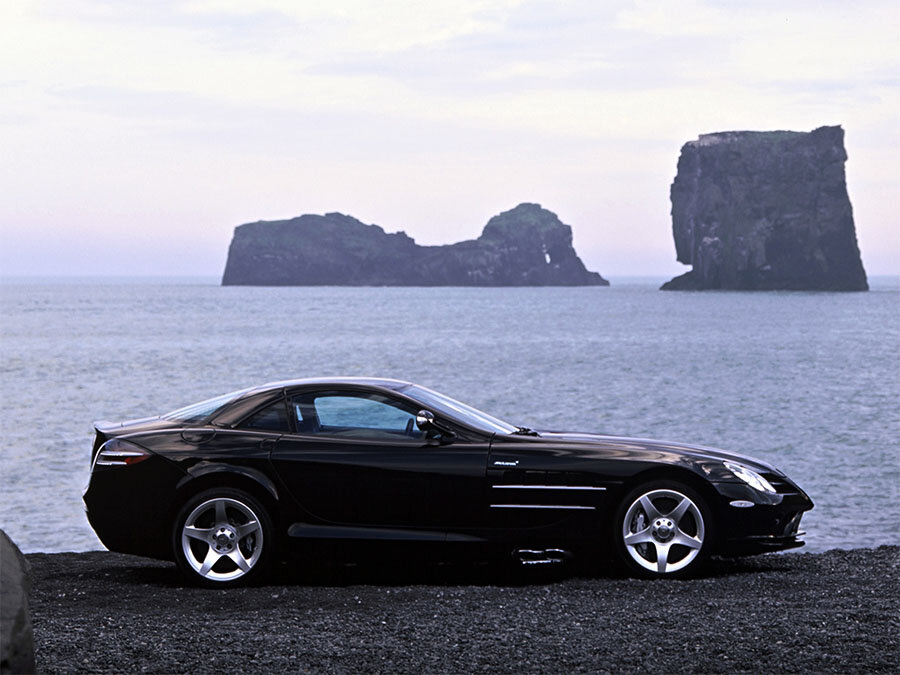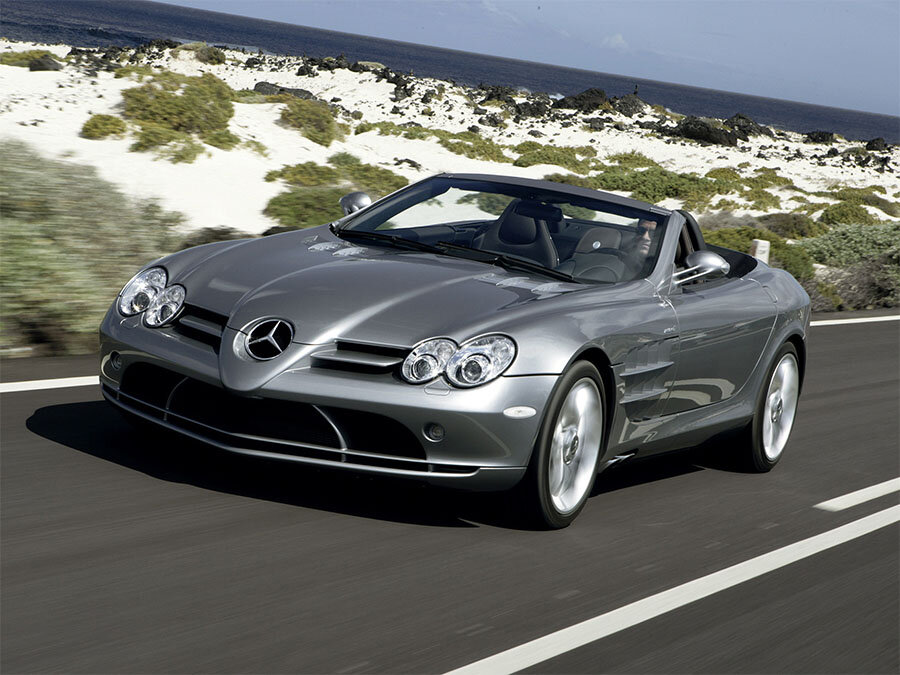Guide: Mercedes-Benz C199 SLR McLaren - a Historical & Technical Appraisal
/BACKGROUND
Arguably the most iconic post World War 2 range of models produced by Mercedes-Benz was the 300 SL line from the 1950s and early 1960s.
The original 1952 W194 sports racing car spawned the W198 Gullwing of 1954 which was followed by a Roadster variant in 1957. There was also the W196S 300 SLR of 1955 which went down as perhaps the single most effective sports racing car of its era.
Unfortunately, when production of the 300 SL Roadster came to an end in 1963, Mercedes did not offer a like-for-like replacement. Instead, the W113 that arrived next was created for mass market appeal and sold at a much lower price than its predecessor.
When the C111 broke cover in 1969, Mercedes enthusiasts were given renewed hope that a true high performance flagship was in the pipeline.
However, despite a large number of potential buyers expressing an interest, Mercedes stuck to their guns and used the cutting edge C111 purely for R&D.
20 years later, it was a similar story with the C112 supercar; on this occasion, Mercedes decided production was not feasible and motorsport success was a better way to enhance the brand.
When the DTM/ITC imploded at the end of 1996, Mercedes commissioned their performance arm, AMG, to design a racing car to contest the FIA GT Championship. For homologation purposes, the CLK GTR Strassenversion was created and became undoubtedly the most extreme road car the firm had ever built.
But, with only 27 produced, it could hardly be considered a successor to the original SL.
The model that would ultimately replace the original SL arrived in concept form at the Detroit Motor Show in April 1999.
The Vision SLR Concept was a modern interpretation of the legendary Silver Arrows from Mercedes’ past. It revived the SLR moniker last seen in 1955 and, following a positive reaction, Mercedes decided to explore how they could bring it to production.
As this assessment was being undertaken, the Vision SLR Roadster Concept was unveiled at the Frankfurt Motor Show in September 1999.
The problem for Mercedes was how to produce such a car; none of their existing factories was geared up for hand-built assembly and the AMG plant was not capable of churning out the number of SLRs that would be required.
Instead, Mercedes turned to their F1 partner: McLaren.
Mercedes and McLaren had begun working together in 1995 when the German firm started to supply the English team with engines for F1.
In late 1999, Mercedes signed a deal that would see the SLR produced at the McLaren Technology Centre in Woking. As part of the plan, Mercedes’ parent company, Daimler, purchased a 40% stake in McLaren during early 2000.
The production version of the SLR Coupe was unveiled on November 17th 2003. Mercedes announced an anticipated run of 3500 units, all of which would be left-hand drive.
CHASSIS
At the SLR’s core was a carbonfibre reinforced plastic monocoque with a 2700mm wheelbase. Compared to the original SLR concept, McLaren moved the engine back to behind the front axle and optimised the design of the centre firewall.
A virtually flat underbody was employed with air baffles for the rear wheels, diffusers ahead of the front wheels and a six channel venturi at the back. So as not to interrupt the airflow, the exhausts were configured to exit from the sides of the car.
Suspension was via aluminium double wishbones with coil springs and twin-tube gas-pressurised shock absorbers. A front anti-roll bar was fitted along with anti-dive and anti-squat geometry. The lower wishbone arms were positioned so that the wheels had a negative camber on spring compression and ensured optimum roadholding when cornering at speed.
Carbon-ceramic brake discs were fitted all round. The internally ventilated front discs had a 370mm diameter and eight-piston calipers. The ventilated rear discs had a 360mm diameter and four-piston calipers.
In wet conditions, the calipers automatically skimmed the surface of the disc to keep them dry.
Sensotronic Brake Control was a brake-by-wire system that employed an anti-lock system and Brake Assist.
Traction control, electronic stability control, power steering and electronic tyre pressure monitoring were also standard equipment.
The 18-inch five-spoke alloy wheels measured 9-inches wide at the front and 11.5-inches wide at the rear. Turbine-style 19-inch forged alloy rims that extracted hot air away from the wheel-wells and brakes were an optional extra.
Dual aluminium fuel tanks with a combined capacity of 98-litres were installed above each side of the rear axle.
ENGINE / TRANSMISSION
In the engine bay was the first Mercedes V8 developed completely by AMG. Designated Type M155.980, it was a hand-built, all-alloy, supercharged 90° V8 with single overhead camshafts per bank and three valves per cylinder (two intake and one exhaust).
Displacement was 5439cc thanks to a bore and stroke of 97mm and 92mm respectively.
The compression ratio was 8.8:1 and a dry-sump lubrication system helped lower the centre of gravity.
The Teflon-coated IHI Lysholm twin-screw supercharger was set at 0.9 bar.
Engine management was courtesy of a Bosch ME-2.8.1 system.
In this configuration, the SLR engine produced a peak output of 617bhp at 6500rpm and 575lb-ft between 3250rpm and 5000rpm.
The engine was coupled to an AMG Speedshift R five-speed automatic gearbox with dry single-plate clutch.
Two fully automatic modes were offered (Comfort and Sport) along with three different Manual settings (Sport, Supersport and Race). Each mode featured progressively shorter shift times than the one before.
In Manual mode, gear changes could be activated by buttons on the steering wheel or using the Touchshift lever on the transmission tunnel.
A five-speed gearbox was chosen over a more complex seven-speed unit for reasons of durability.
BODYWORK
As per the SLR’s monocoque, the bodywork was made from carbonfibre composite.
The long hood featured a plunging arrow-shaped nose complete with three-pointed star that served as an intake snorkel for the supercharger. Additional ducts were located inboard of Mercedes’ trademark twin Bi-Xenon headlights.
At the base of the front apron was a dual aerofoil with curved supports that were typical of period F1 cars.
Down each side were 300 SLR-inspired engine cooling vents and chromed dual exhausts that exited ahead of butterfly doors attached to the A pillars. The doors pivoted forwards and upwards in a wide arc that allowed easy access to the cockpit.
The taught cockpit swept down to a short tail that incorporated LED lights and a retractable bootlid-mounted flap which served as a combined spoiler / air brake. At 95kmh, the flap was automatically deployed at a 10° angle to increase rear downforce. It was also activated at an angle of 65° under hard braking to ensure optimum deceleration.
Manual activation of the spoiler / air brake was also possible if required.
INTERIOR
The interior was a mixture of leather, aluminium and carbonfibre.
Directly behind the three-spoke steering wheel was a curved binnacle that housed all the instrumentation. A large speedometer and rev counter were inset with an array of warning lights and digital read outs. The speedo and tach were flanked by smaller gauges for water temperature and fuel.
An aluminium centre console housed a pair of air vents, controls for the transmission modes and the air-conditioning switchgear. There was also a flip-up SLR-branded panel that concealed the audio and satellite navigation systems.
The engine start button was under a cover on top of the gear lever.
The leather-trimmed carbonfibre sports seats came with six-way power adjustment and custom-sized inserts in one of five sizes: Small, Medium, Large, XL or XXL.
Other standard equipment included dual-zone air-conditioning, a seven-speaker Bose audio system with six-disc CD autochanger, Bluetooth wireless connectivity, electric windows, heated electric mirrors, cruise control, six airbags, remote keyless entry and rain-sensing wipers.
SLR ROADSTER
An SLR Roadster was unveiled in September 2007. It came with unique carbonfibre crash structures, steel reinforced A-pillars and two fixed roll-over bars behind the seats.
The Roadster’s electric canvas roof could be ordered in three different colours: Beige, Red or Anthracite. Once manually unlocked from the front window frame and pushed upwards, the roof electronically folded away in under ten seconds. When lowered, it was concealed from view.
OPTIONS
In addition to the 19-inch turbine alloy wheels, buyers could specify a carbonfibre interior package, Red or Gold brake calipers, upgraded Silver Arrow leather, a two-tone steering wheel, floor mats with leather edging and contrast stitching for the upholstery.
When the uprated 722 Edition was launched in 2006, its bigger 19-inch Brake System that consisted of 390mm front brake discs with red calipers could also be specified.
WEIGHT / PERFORMANCE
The SLR Coupe weighed in at 1743kg and the Roadster was 1791kg.
Mercedes quoted a 0-62mph time of 3.8 seconds for both variants along with a top speed of 208mph.
PRODUCTION
Production of the Coupe began in April 2004 and lasted until June 2008.
Roadster production started in August 2007 and ended in May 2009.
In total, 2157 SLRs were built.
A further 300 722 Edition cars were assembled plus 75 Stirling Moss variants (both covered separately).
Even when factoring these additional models into the equation, Mercedes were well short of the 3500 units they expected to deliver.
The SLR was effectively replaced by the Gullwing-doored SLS AMG from 2010.
Text copyright: Supercar Nostalgia
Photo copyright: Mercedes-Benz - https://www.mercedes-benz.com



































